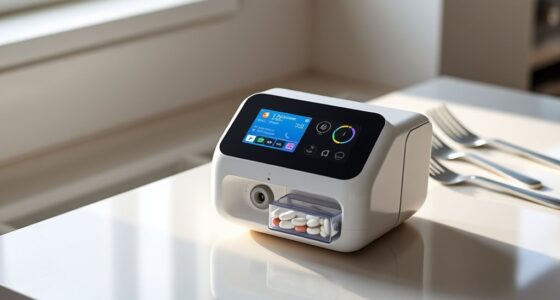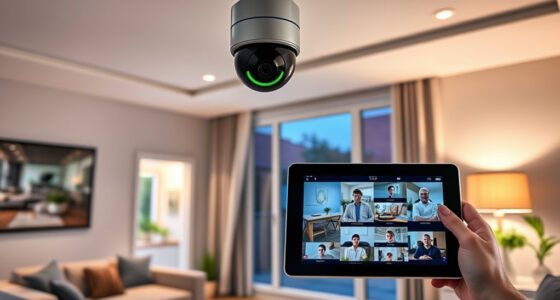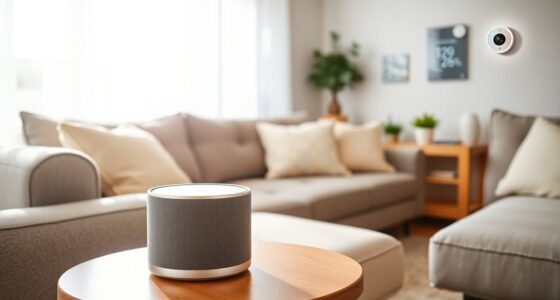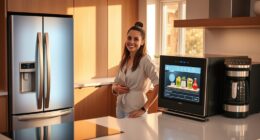Using environmental sensors for indoor air quality monitoring helps you guarantee a healthier space by detecting pollutants, humidity, and temperature in real time. Proper sensor placement is key—position them in busy areas like kitchens or near vents to get accurate data. Modern wireless and smart sensors give instant alerts, allowing you to act quickly and improve air quality. By understanding airflow and pollution patterns, you can create a safer environment—discover more about optimizing your indoor air quality.
Key Takeaways
- Proper placement of sensors in high-occupancy or pollution-prone areas ensures accurate indoor air quality monitoring.
- Modern wireless sensors with smart features provide real-time alerts and seamless integration with automation systems for health safety.
- Continuous data collection helps identify pollution sources, ventilation issues, and patterns impacting indoor air quality.
- Regular maintenance and calibration of sensors maintain data accuracy, supporting effective health and safety decisions.
- Effective deployment of environment sensors creates safer indoor environments by enabling proactive measures and immediate responses.
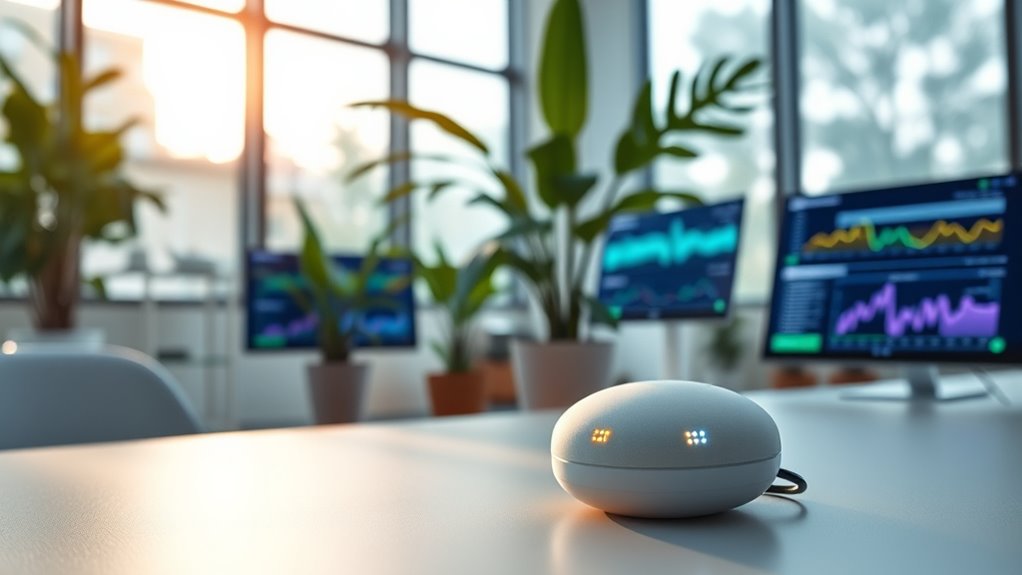
Have you ever wondered how you can guarantee the air inside your home or office is safe and healthy? The answer lies in understanding and monitoring air quality, which can be achieved through effective sensor deployment. These modern sensors provide real-time data on pollutants, humidity, temperature, and other airborne elements, giving you the tools to ensure a healthier environment. Proper sensor deployment is vital because it determines the accuracy and reliability of the data you gather. If sensors are poorly positioned or overlooked, you might miss critical fluctuations in air quality, leading to unnoticed health hazards. When deploying sensors, consider areas where people spend most of their time or places prone to pollution buildup, such as kitchens, near windows, or HVAC vents. This strategic placement helps capture a complete picture of indoor air quality, letting you take proactive measures to improve it.
Sensor deployment isn’t just about placing devices randomly; it’s about understanding your space and its airflow patterns. For example, air tends to circulate differently in various parts of a room or building, so positioning sensors at different heights and locations ensures you don’t get a skewed reading. You want your sensors to detect changes in air quality as they happen, so you can respond swiftly. Modern sensors are often wireless and easy to install, making it simpler to cover large or complex spaces without extensive wiring or infrastructure. Many come with smart capabilities, allowing you to connect them to your smartphone or home automation system. This connectivity lets you receive alerts when air quality drops below safe levels, empowering you to act immediately—whether that’s increasing ventilation, using air purifiers, or adjusting HVAC settings. Additionally, some sensors can be integrated with Car Brands tuning systems to optimize vehicle air quality in connected environments.
Monitoring air quality with sensors also provides invaluable data over time. You can track patterns and identify sources of pollution or poor ventilation that might be affecting your health or comfort. This ongoing insight helps you make informed decisions about your space’s environment, improving both safety and energy efficiency. Remember, the goal of sensor deployment isn’t just to gather data but to create a healthier indoor environment. Regularly maintaining and calibrating your sensors ensures continued accuracy, so you can trust the information they provide. Ultimately, investing in good sensor deployment and understanding how to interpret the data they deliver enables you to take control of your indoor air quality—making your home or office a safer, more comfortable place to be.
Frequently Asked Questions
How Often Should Indoor Air Quality Sensors Be Calibrated?
You should calibrate your indoor air quality sensors at least once every 6 to 12 months. Regular sensor calibration guarantees accurate readings and reliable data. Follow your device’s maintenance schedule, which might recommend more frequent calibration depending on usage and environment conditions. Keep an eye on sensor performance, and if readings seem off, perform calibration sooner. Proper maintenance keeps your indoor air quality monitoring effective and trustworthy.
What Is the Most Cost-Effective Sensor for Home Use?
You should consider a handheld CO2 or VOC sensor for home use, as they often offer the best cost comparison. These sensors are affordable upfront and typically have a sensor lifespan of 2-3 years, making them cost-effective over time. While more advanced models exist, their higher prices may not suit your needs unless you require detailed data. Always balance initial costs with sensor longevity for the most economical choice.
Can Sensors Detect All Indoor Pollutants Accurately?
Sensors can’t detect all indoor pollutants accurately due to sensor limitations. While they are effective at monitoring common pollutants like VOCs, CO2, and particulate matter, they often struggle with gases like formaldehyde or radon. You should understand that no single sensor can provide complete pollutant detection. For exhaustive indoor air quality, combining multiple sensors or professional testing gives you a more accurate picture of your environment.
How Do Environmental Sensors Impact Energy Consumption?
Environmental sensors improve energy efficiency by providing real-time data that helps you optimize heating, cooling, and ventilation systems. With sensor integration, you can adjust settings based on occupancy or air quality, reducing unnecessary energy use. This targeted approach guarantees your space stays comfortable while consuming less power, ultimately lowering energy costs and minimizing environmental impact. You actively manage energy consumption, making your indoor environment smarter and more sustainable.
Are There Privacy Concerns With Indoor Air Quality Monitoring?
While indoor air quality monitors track your health, privacy concerns and data security risks can arise. You might worry about who accesses your data and how it’s stored, especially since sensitive information could be exposed. Yet, these sensors aim to protect you by providing healthier environments. Staying informed and choosing trusted devices helps balance the benefits with the privacy concerns, so you can breathe easier without sacrificing security.
Conclusion
By using environmental sensors to monitor indoor air quality, you take control of your health—because air quality isn’t just background noise, it’s the foundation of well-being. Think of these sensors as your vigilant guardians, constantly watching over your space. Don’t wait for symptoms to appear; be proactive. Remember, clean air isn’t a luxury, it’s a necessity—so breathe easy, knowing you’re empowered to create a healthier home environment.

